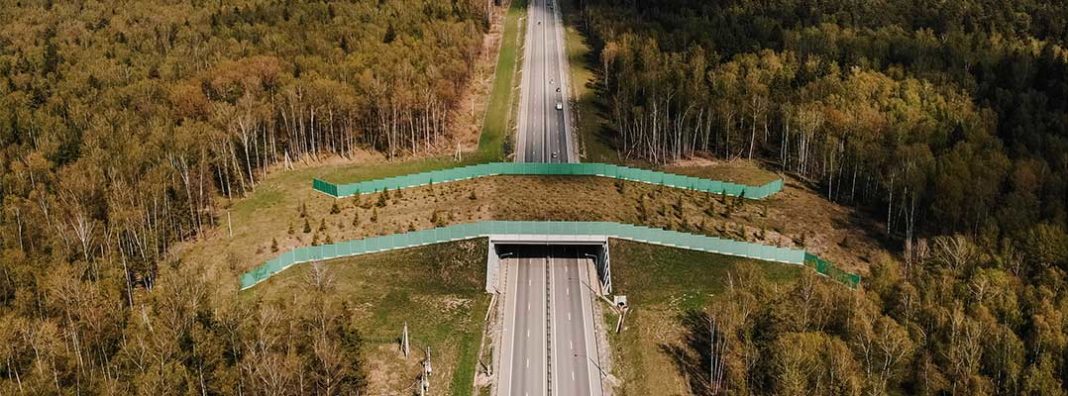
Today, the world’s largest wildlife crossing broke ground in Los Angeles. When completed in 2025, the bridge will span a massive Southern California highway, and give big cats, coyotes, deer, lizards, snakes, and other creatures safe passage to the Santa Monica Mountains.
The bridge will be the first of its kind near a major metropolis and the largest in the world. Of the $90 million to be spent, about two out of every three dollars was raised via private donations, with the rest coming from public funds set aside for conservation purposes. The span will be named the Wallis Annenberg Wildlife Crossing, for the philanthropist whose foundation donated $25 million.
Only rich societies can build this kind of infrastructure. Indeed, rich societies are the only ones that build wildlife crossings. Other rich countries, including the Netherlands, Switzerland, Germany, and France, have built wildlife crossings like this one.
Some might think that the Wallis Annenberg bridge is an example of the excesses of wealth and philanthropy. But it also exemplifies what wealth can achieve. The economic question isn’t why one person has so much money, it’s how do we make everyone wealthy enough to be able to do this?
The idea that we could all be much wealthier than we are today is not an outrageous claim. Sometime in the 1970s, growth rates got off track. Had we grown 2 percent per year, instead of the actual 1 percent, the median household would be twice as wealthy as it is today. Just continuing in 1970 instead of getting stuck would mean that the median household would have around $150,000 in income instead of today’s $79,900.
If productivity from 1973 to 2016 had grown at the same rate as it did from 1949 to 1973, everyone would be much richer. Using far more sophisticated techniques than hypothetical curves, economists Anna Stansbury and Lawrence Summers estimated that compensation should have been 41 percent higher in 2016. In a review of Bureau of Labor Statistics data, James Pethokoukis explained that this loss equates to $11 trillion in economic output.
Wealth and income inequality tend to dominate the conversation about labor, but there needs to be a reweighting towards growth.
Rich societies can do a lot more for their citizens. Regardless of one’s views on tax rates, rich societies have more fiscal capacity. They can spend more on healthcare, education, and work programs because they are collecting taxes from wealthier people.
Wealthier societies can also spend more to mitigate the effects of climate change. They can afford the cost of building dams to stop the rising tides. They can afford the cost of carbon removal. They can afford the disruption that comes with adapting to climate change.
The United States will bear a substantial burden from climate change in the coming decades. Some have suggested that we need to completely stop growth to solve climate change. Not so. Only broad-based prosperity coupled with ingenuity will give us the tools necessary to solve the problems created by climate change.
The answer isn’t degrowth, it’s abundance
In the face of our climate challenge, some now argue that the only way to reverse climate change is to radically reorganize the economy. As Jason Hickel recently tweeted, “We can have a democratic economy organized around meeting human needs at a high standard, where production is socially just and ecologically regenerative. Such a system is possible, but it will require a political movement to bring it into being.”
Hickel is the author of Less is More: How Degrowth Will Save the World, a treatise on degrowth. As he explains in that manuscript, “All of this complexity opens up real questions about our ability to control global temperatures…And that means cutting global emissions to zero much, much faster than anyone is presently planning.”
Recent history has not been kind to the degrowth agenda.
For one, some of the largest economies have been able to decouple their growth from emissions. The United States, for example, is back down to the emission levels of the early 1990s, largely due to renewables like wind and solar. But the U.S. isn’t alone. The United Kingdom, France, Germany, Sweden, Finland, Denmark, Italy, Czechia, and Romania have all been able to continue growing their economy while reducing emissions.
Second, Covid-19 acted as a natural experiment giving everyone a small taste of what a degrowth world might look like. Instituting lockdowns had the effect of keeping people in their homes, limiting what they could do. This is the essential end result of degrowth, a world of less.
Altogether, the economic restrictions reduced carbon emissions by about 5.5 percent, but they impacted global GDP to the tune of nearly 10 percent. Covid-19 might have temporarily reduced emissions, but it created immense hardships, dislocation, and poverty.
Politically, degrowth will never be a winner.
Third, and most importantly, degrowth advances a defeatist mindset when trying to solve our toughest public policy problems. Climate change is an incredible challenge that needs to be met. What’s needed isn’t degrowth, but ingenuity coupled with material abundance.
The financial services company Stripe has shown the way. As Nan Ransohoff of the company explained, “The magic of Stripe Climate is that it’s powered by thousands of companies who are collectively buying Frontier carbon removal down the cost curve.” In other words, it maintains a portfolio of investments not only to remove carbon, but also make carbon removal cheaper over time.
As Robinson Meyer recently detailed,
The company has now contracted to buy carbon removal from 14 different start-ups. They include CarbonBuilt, which is trying to sequester carbon by capturing it in concrete; the Future Forest Company, which seeks to accelerate the natural process of rock weathering; and Project Vesta, which wants to line beaches with a carbon-capturing mineral called olivine. Stripe was just a customer for those start-ups, providing them with money today to capture carbon in the future. As I wrote last year, Stripe—and now Frontier—aims to be a “buyer of first resort,” sending a demand-side signal to entrepreneurs and investors that a large market for permanent carbon removal exists.
The United States needs to invest in a bundle of solutions as well. We should remove burdensome rules that stand in the way of low-cost, low-carbon energy like geothermal and nuclear. The government should also help bend the cost curve for carbon removal by investing in basic research into the topic. Moreover, we must re-examine environmental rules that make it more difficult to upgrade our electrical grid, build utility-scale solar power, and even build wildlife bridges.
Wildlife bridges are a clear expression of a society that wants to make the world a better place. But that can only happen when prosperity is linked to action. On this Earth Day, let’s remember: The only way to make Earth a better place is by joining abundance and ingenuity.

